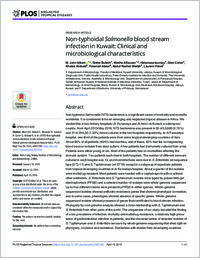Non-typhoidal Salmonella blood stream infection in Kuwait: Clinical and microbiological characteristics
- Albert, M. John Department of Microbiology, Faculty of Medicine, Kuwait University, Jabriya, Kuwait
- Bulach, Dieter Microbiological Diagnostic Unit, Public Health Laboratory, Peter Doherty Institute for Infection and Immunity, The University of Melbourne, Victoria, Australia
- Alfouzan, Wadha Department of Microbiology, Faculty of Medicine, Kuwait University, Jabriya, Kuwait - Microbiology Unit, Department of Laboratories, Al Farwaniya Hospital, Sabah Al-Nasser, Kuwait
- Izumiya, Hidemasa National Institute of Infectious Diseases, Tokyo, Japan
- Carter, Glen Microbiological Diagnostic Unit, Public Health Laboratory, Peter Doherty Institute for Infection and Immunity, The University of Melbourne, Victoria, Australia
- Alobaid, Khaled Department of Microbiology, Al Amiri Hospital, Sharq, Kuwait
- Alatar, Fatemah Microbiology Unit, Muabarak Al Kabeer Hospital, Jabriya, Kuwait
- Sheikh, Abdul Rashid Department of Microbiology, Al Amiri Hospital, Sharq, Kuwait
- Poirel, Laurent Department of Medicine, University of Fribourg, Switzerland
- 15.04.2019
Published in:
- PLOS Neglected Tropical Diseases. - 2019, vol. 13, no. 4, p. e0007293
English
Salmonella organisms are classified into typhoidal Salmonella (causing enteric fever) and non-typhoidal Salmonella (NTS) (causing infections other than enteric fever). Apart from causing other infections, NTS causes blood-stream infection (bacteremia and septicemia). NTS blood stream infection (NTS-BI) is considered to be an emerging and neglected tropical disease in Africa. It causes a very high morbidity and mortality in Africa. The individuals affected in Africa are children, malnourished people, patients with malaria or HIV etc. These conditions affect the immune system and make them vulnerable to infection with NTS. In these patients, diarrheal disease due to NTS is rare. The majority of infections are due to two types of NTS: Typhimurium and Enteritidis. There is a very high prevalence of multidrug-resistance in NTS making the infection difficult to treat. NTS-BI is also present in other parts of the world including developed countries albeit at a lower prevalence. Kuwait is a high- income, subtropical country in transition (from a developing to developed country), located in the Middle East. We studied NTS-BI in Al Farwaniya and Al Amiri hospitals in Kuwait during April 2013 to May 2016. Out of nearly 30,000 to more than 50,000 blood cultures done in these hospitals, NTS was present in 0. 75 to 1.33% of blood cultures, representing a very small proportion of blood cultures, unlike in Africa. This showed that 31 patients in Al Farwaniya hospital and 30 patients in Al Amari hospital had NTS-BI. Most of these patients had underlying illnesses such as diabetes, lung infection, cancer etc. that affect the immune system, as in Africa. Many patients also had diarrheal disease caused by the same NTS that caused blood stream infection, unlike in Africa. Only two patients in each hospital died, a low mortality, unlike in Africa. The majority of the isolates belonged to Typhimurium and Enteritidis as in Africa. Even though resistance to drugs was a problem, about quarter of the isolates only were multidrug-resistant, a lower prevalence compared to in Africa. In Kuwait, we performed a detailed genetic study of a selected number of Typhimurium and Enteritidis isolates by a modern technique called whole genome sequencing. This revealed genetic determinants encoding drug-resistance and virulence causing blood- stream infection. This type of study was not performed in African isolates. Thus, our study revealed similarities and differences with studies of NTS-BI in Africa.
- Faculty
- Faculté des sciences et de médecine
- Department
- Médecine 3ème année
- Language
-
- English
- Classification
- Biological sciences
- License
-
License undefined
- Identifiers
-
- RERO DOC 326781
- DOI 10.1371/journal.pntd.0007293
- Persistent URL
- https://folia.unifr.ch/unifr/documents/307938
Statistics
Document views: 83
File downloads:
- pdf: 188
